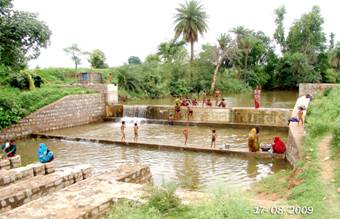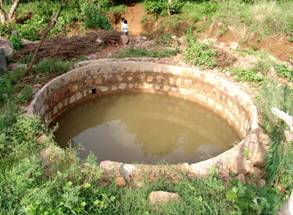Garhkundar-Dabar Watershed project:A successful model for water conservation in Bundelkhand region
New Delhi
A water conservation model for the drought prone Bundelkhand region has been successfully developed and tested in Garhkundar-Dabar area by the ICAR scientists at the National Research Centre for Agroforestry (NRCAF), Jhansi. The model has shown a promising way to fight drought in the region and so may help to bring in greenery and prosperity there.
Bundelkhand region is spread over 7.16 million ha in the central India covering seven districts of Uttar Pradesh (Jhansi, Jalaun, Lalitpur, Hamirpur, Mahoba, Banda and Chitrakoot) and six districts of Madhya Pradesh (Sagar, Tikamgarh, Chhatarpur, Panna, Damoh and Datia). The region has semi-arid climate with an average annual rainfall of 750-1100 mm. Most of the soil in the region is rocky having low capacity for holding water and rest is prone to water logging. Hence, making is difficult for agricultural operations. The forest cover is also confined to only 21.4%, which at regions is even less than 11%. Garhkundar-Dabar area, some 55 km from Jhansi on the Jhansi-Khajuraho Road, represents the geological, physiographical and ecological conditions of the entire Bundelkhand region. For this reason, NRCAF selected Garhkundar-Dabar area as a model for developing

Implementation of the project in Garhkundar-Dabar area included the construction of nine checkdams, 150 gabions, 15 drainage structures, three water spreaders and field bunding of 40 ha along the Nallah. With a construction cost of Rs.19.74 lakhs only, the project has resulted in a water storage capacity of 24103 m3 spread in an area of 40302 m2. This has resulted in a reduction of soil loss and runoff by 34% in treated areas as compared to 43% reduction in untreated/control area. More than 53.3% wells in the region have recorded an increase of water level by more than two metres. Water replenishment through watershed project has reduced the number of dry wells to 2% in 2009 as compared to 86% in 2006. Now sufficient water is available in the region for drinking and irrigation purposes. Earlier surface water in Nallahs was available for four months only, which is now available for the entire year.
Cropping intensity in the watershed area has increased to 116% as compared to 96% in untreated area. Productivity of wheat and groundnut increased from 2424 to 2845 Kg per ha and from 1180 to 1320 Kg per ha respectively in the treated area. Now farmers in the watershed area are increasingly using improved seeds for cultivation and their number has gone up to 67%. With the increased availability of water and with the proper use of agro-techniques, seed rate of wheat has gone down from traditional rate of 240 Kg per ha to 125 kg per ha. This reduced seed rate led to a net saving of 101 quintal seeds of wheat from 175 ha cropped area.
 The Garhkundar-Dabar area watershed project covering an area of 850 ha has benefited 191 households having a total human population of 891. Five farmers adopted aonla, guava and citrus based agroforestry system in four hectare area. One farmer planted live fencing of karonda along 100m of the field boundary. About 6000 forest tree saplings were planted along the Nallah, teak plantation was done on 0.23 ha of private land and about 250 ber plants were topworked. The project committee has also encouraged the formation of self help groups for personal loaning and capacity building. Two women self help groups have gathered assets of Rs. 35,000 and Rs 25,000 respectively and have successfully gained self-reliance in terms of small credit requirements. The project construction work also created about 7000 mandays employment during the year 2006-07 and 7500 additional mandays during the next year 2007-08 for various other interventions and activities. It is further expected that an employment of 29000 mandays per annum will be generated from enhanced agricultural activities.
The Garhkundar-Dabar area watershed project covering an area of 850 ha has benefited 191 households having a total human population of 891. Five farmers adopted aonla, guava and citrus based agroforestry system in four hectare area. One farmer planted live fencing of karonda along 100m of the field boundary. About 6000 forest tree saplings were planted along the Nallah, teak plantation was done on 0.23 ha of private land and about 250 ber plants were topworked. The project committee has also encouraged the formation of self help groups for personal loaning and capacity building. Two women self help groups have gathered assets of Rs. 35,000 and Rs 25,000 respectively and have successfully gained self-reliance in terms of small credit requirements. The project construction work also created about 7000 mandays employment during the year 2006-07 and 7500 additional mandays during the next year 2007-08 for various other interventions and activities. It is further expected that an employment of 29000 mandays per annum will be generated from enhanced agricultural activities.
Human resource development activities were also carried in the watershed where farmers were trained for various agro-techniques through awareness and visit programmes. In addition, livelihood support activities like lac cultivation, gum and resin tree cultivation, fish farming in checkdams and goat rearing were also introduced. This way, NRCAF scientists have successfully changed the scenario of life, agriculture and livelihood and so bringing happiness and greenery in the drought prone Garhkundar-Dabar area. The success of this project opens doors for its replication in the entire Bundelkhand region. According to Dr. S. K. Dhyani, Director of NRCAF, there was plenty of water available in the checkdams and wells in the region despite of the insufficient rainfall this year. He says that such a success was not possible without the participation and cooperation of the farmers.
According to NRCAF, Garhkundar-Dabar Watershed as a model is replicable to 56% red soils of Bundelkhand region, Vindhyanchal range, Satpura and Arawali ranges. Successful adoption and replication of these water conservation techniques and agrofestry can help overcome the problems of soil erosion and water crisis for drinking as well as for irrigation in the entire region of Bundelkhand.
(Source: NAIP – Mass Media Project, DIPA)








Like on Facebook
Subscribe on Youtube
Follow on X X
Like on instagram